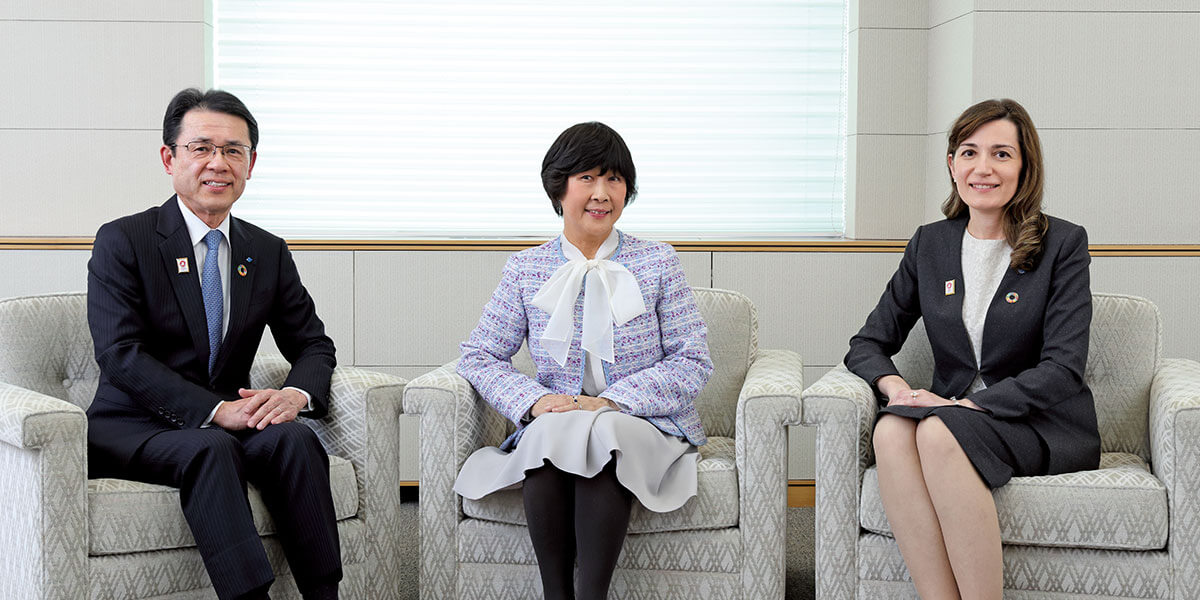
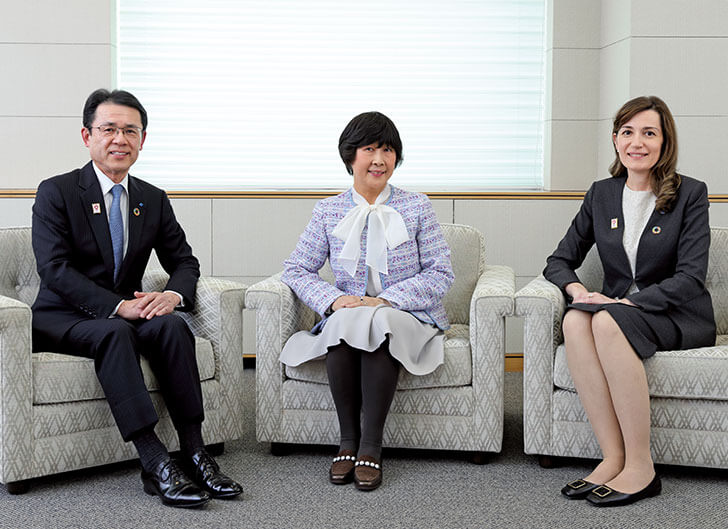
True DE&I Enables Individuals to
Shine and Demonstrate Their Full Potential
The concept of diversity, equity, and inclusion (DE&I) is not just limited to the empowerment of women. Although empowering women is one of its starting points, the end goal is to link employee growth to business growth by establishing a foundation for the empowerment of a diverse range of human resources. President Satoru Yamamoto, Outside Director Mari Sonoda, and Outside Audit & Supervisory Board Member Asli M. Colpan sat down to discuss the Company’s DE&I vision, challenges, and initiatives.
Yamamoto
The Sumitomo Rubber Group handles cutting-edge rubber technologies and we have produced many Japan-first and world-first products. We have inherited this pioneering spirit and willingness to take on challenges, and going forward, we want to create new value. Therefore, we recognize that promoting DE&I is an important step toward achieving this.
Our Philosophy states our Purpose as “Through innovation we will create a future of joy and well-being for all.” It also contains a Vision that enables us to embody this Purpose, which is “Uniting our diverse strengths, growing together, driving and thriving on change.” I am confident that if we bring together the abilities of our diverse workforce in a way that empowers individuals to shine and ensures mutual respect, then we will be able to provide stakeholders with greater joy and well-being.
Sonoda
Looking back over the last year, I would first like to say that President Yamamoto has demonstrated a firm commitment to DE&I. The number of Board of Directors discussions that are rooted in DE&I has increased and I feel that the attitude toward DE&I shown by officers has shifted from “Why?” to “How?” Progress is being made on encouraging men to take childcare leave and promoting women into management positions. Also, improvements to factory workplace environments that we have been requesting for some time have started. Furthermore, a lot of women employees and young employees, who were rarely involved in decision-making in the past, are participating in the “Be the Change” Project, which is creating an atmosphere that facilitates exchanges of opinion that transcend organizational barriers. This has not only raised employee motivation, but also led to profit contributions.
Colpan
One change we have seen this fiscal year is an increase in the number of women among outside officers to three. The Company is looking to raise its percentage of management positions held by women to at least 7% by 2025, and I think we should create a target for top management positions as well. In the medium to long term, we need to formulate targets for the number and proportion of women in manager and general manager positions, create a career ladder, and then analyze what we need to achieve these targets. I feel that it will be essential to promote female employees using various internal and external programs and support measures.
Yamamoto
It is reassuring that DE&I initiatives are being advanced under the lead of a team in charge. I am promoting it while still learning about the subject myself. I would like to continue to educate myself and show even stronger leadership.
As you both say, the empowerment of women and young employees is essential. We have switched the framework for our efforts from D&I to DE&I. Naturally, empowering women is a key issue from an equity perspective. Women are the largest minority within the Company so if we can create an environment that empowers women, it will also create a more friendly and empowering working environment for other minorities and for the men who make up the majority of workers.
Sonoda
We should be aiming to be a company where not only women, but also fathers who are rearing children, people with illnesses, people with parents who require nursing care, and other employees with specific needs, can take advantage of various systems to enjoy a dynamic working life. Currently we are advancing DX on a company-wide basis and I think this has an important connection to realizing more employee- friendly environments and developing human resources.
Yamamoto
It is embarrassing to admit, but we still have many employees working long hours. To create employee-friendly working environments, we have to correct long working hours as a priority issue. Therefore, we need to use DX to make work operations more efficient and advanced. If we can improve time efficiency through DX, employees will be able to enjoy better work-life balances and focus on the work they really want to do. Right now, we are determinedly advancing DX with the goal of completing structural reforms by 2025.
Yamamoto
Last year, I had the opportunity to exchange opinions with Ms. Sonoda and Ms. Colpan at a study session for officers. During this session, Ms. Sonoda said “Child-rearing is a career,” which made a strong impression on me. If men are able to take childcare leave and become more involved in parenting, it not only builds stronger partnerships, but also cultivates a sense of imagination that is more empathetic to people and society.
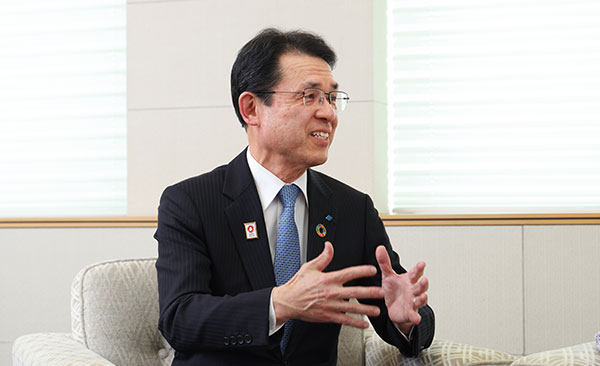
Sonoda
Working at a company generally involves doing a single task efficiently, but parenting usually involves handling many different tasks at the same time. It is an excellent way to develop multitasking management ability.
Yamamoto
We need environments where people can take childcare leave without creating personnel shortages that hinder operations. I think it is important that people feel able to ask for support when there is something they cannot do by themselves. Nobody is perfect, we all have some weakness. Within the Company, many of our employees tend to take their jobs very seriously, which can make it difficult for them to ask for help easily. Therefore, we need to show interest in our colleagues’ work and support one another as a team. To realize environments where you can ask for help. This is the organizational vision that we are really aiming for.
Sonoda
Sonoda
In regard to environments where operations can continue even if someone is away, childcare leave is usually scheduled so there is a certain amount of flexibility. However, some situations happen without warning, such as collapsing from illness or a parent needing nursing. There is a tendency among Japanese people to try and endure, so they often end up overdoing it at work despite illness, or quitting their job because they feel a responsibility to provide nursing care. Both of these instances have a negative effect on both the individual and the workplace. In the coming times, I feel that organizations that do not have the structural ability to respond to personnel absences will not be able to survive.
Yamamoto
Touching on the empowerment of women, I am a member of the Cabinet Office’s Male Leaders Coalition for Empowerment of Women. At the coalition, I have made a declaration that states, “We will discover women with potential and provide career opportunities that empower women and environments that facilitate work-life balance so that they shine even brighter. We believe that proactively creating career opportunities and environments that empower women will lead to corporate cultures that empower diverse workforces and realize companies that have higher productivity and greater corporate value.” In 2021, we introduced a mentoring system at the Company and now 51 employees are active as mentors. Also, as part of efforts to identify and develop women as candidates for upper management positions, last year we appointed five women as general managers. I think this is a positive result.
Colpan
I feel that President Yamamoto has not only made a commitment, but has also turned it into real action. In regard to developing candidates for upper management positions, as you just mentioned, we established a Women’s Executive Leadership Program at Kyoto University last year. Two female employees from Sumitomo Rubber Industries are participating. This has been well received and I feel I was also able to contribute.
It will take time to raise the percentage of management positions held by women, first in manager positions, then general manager positions, and then finally as officers. To speed this process up, we need leadership from above. I think we need to take advantage of a wide range of programs, including the Kyoto University program and the mentoring system.
Yamamoto
The Sumitomo Rubber Group operates as a global organization, so it is essential that we grow with global personnel as our core workforce. Last year, we held a meeting called “Global Summit” in Japan, gathering the CEOs of overseas Group companies. It produced great results. Previously communication had been channeled through Japanese expatriates, so changing this to direct communication raised the speed and quality of decision making.
Colpan
As President Yamamoto said, efforts to make our workforce more diverse in terms of nationality have been advanced. On the other hand, I feel that inclusiveness has yet to be fully realized. Rather than thinking of certain colleagues as employees from overseas subsidiaries, it is important to think of them as fellow Sumitomo Rubber Group employees. Therefore, I would like there to be more opportunities for overseas colleagues to come to Japan and participate in meetings. Raising English-speaking ability and realizing direct communication is standard for a global organization.
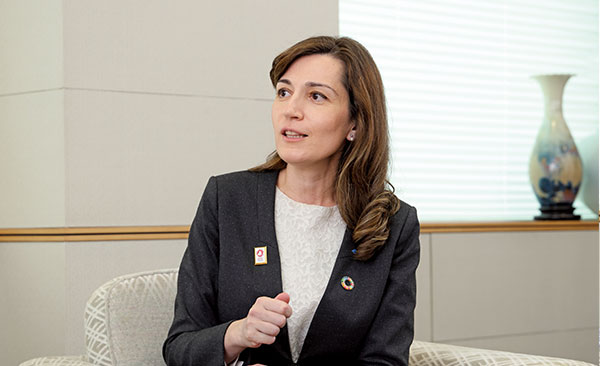
Sonoda
I think there are two approaches we need to take as a global organization. One is to entrench our Purpose and Vision at overseas locations and develop models that leverage the characteristics of our philosophy. The other is to develop human resources who can thrive in overseas markets and transactions. These mean that it is important to have diversity and organizational capabilities. A group of similar people will only produce similar opinions, while a diverse group will produce diverse opinions. Ideas for the future will be found within these diverse opinions.
Additionally, risk management is extremely important for globalization.
In an international environment, Japanese companies have to face dangers they have never experienced before. It is difficult for a homogenous organization to spot a risk at an early stage, consider what to do, and resolve it quickly. Therefore, it is important to be an organization that empowers diverse human resources in order to stay sensitive to risk and to deal with it swiftly.
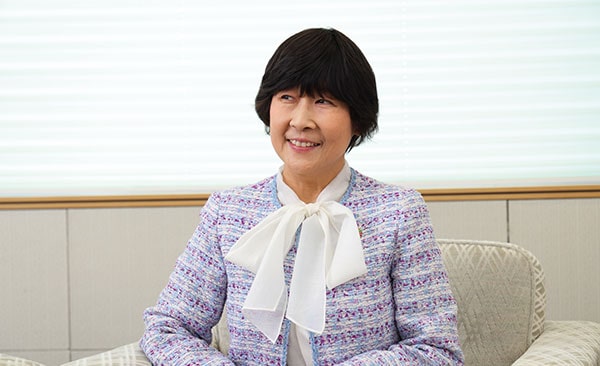
Yamamoto
Since we started promoting DE&I, I have started noticing that internal meetings often comprise the same people and there are not many women and young people among them. In order to build a strong organization, I feel it will be important to have more diverse members in these meetings and to empower them to speak. It will be an opportunity for me to get to know more employees and for the employees themselves, gaining experience of big meetings is an opportunity for growth.
We recognize that the way we have categorized diversity in the past, with a focus on experience and attributes, is just a waypoint. True DE&I means that every Group employee is respected as an individual and empowered to demonstrate their full potential and shine. I would like to find people who are fulfilling their potential and share them with all our Group employees. I would like to shine the spotlight on them so their brilliance is also recognized by their colleagues. Therefore, it is the responsibility of management including myself to build frameworks, develop people, and foster a culture that enables this. Speaking to you both today has reaffirmed my resolve. I will be proactive in recognizing my unconscious biases, fostering proper psychological safety grounded in discipline, and creating workplaces where everyone can participate freely and openly.
